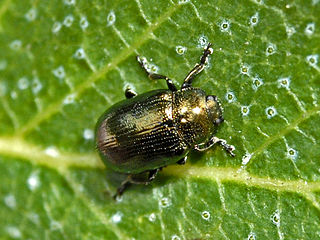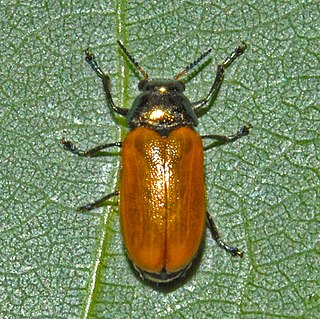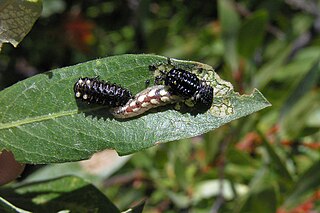
The insects of the beetle family Chrysomelidae are commonly known as leaf beetles, and include over 37,000 species in more than 2,500 genera, making up one of the largest and most commonly encountered of all beetle families. Numerous subfamilies are recognized, but the precise taxonomy and systematics are likely to change with ongoing research.

The blue willow beetle, formerly Phyllodecta vulgatissima, is a herbivourous beetle of the family Chrysomelidae. It is dark with a metallic sheen that ranges from a blue color to bronze. It is distinguished from P. vitellinae by the latter more commonly displaying bronze coloration. European Phratora species can be distinguished based on morphology of female genitalia. The larvae undergo three instar stages from hatching to pupation. This beetle is found throughout Europe and Scandinavia, and occurs in China.

The Chrysomelinae are a subfamily of leaf beetles (Chrysomelidae), commonly known as broad-bodied leaf beetles or broad-shouldered leaf beetles. It includes some 3,000 species around the world.

The leaf beetle Chrysomela lapponica is found in central and northern Europe feeding on leaves of willows and birch. The adult beetles are about 8 mm long and beetles in different regions can have different colour patterns on their elytra.

Chrysomela populi is a species of broad-shouldered leaf beetle belonging to the family Chrysomelidae, subfamily Chrysomelinae.

Parasyrphus nigritarsis is a species of hoverfly, from the family Syrphidae, in the order Diptera. It is known from northern Europe and North America, and has been considered to be a rare species in parts of its range. Adults visit flowers as a source of nutrition, and females lay their eggs on clutches of eggs of leaf beetles. When the Parasyrphus larvae hatch, they first consume leaf beetle eggs and then consume immature beetles until they reach the pupal stage. This species is related to hoverflies that prey on aphids as larvae, and has been investigated in studies of chemical ecology and food web ecology.

Clytra quadripunctata is a species of leaf beetle in the subfamily Cryptocephalinae. Its common name is Four spotted leaf beetle.

Phratora is a genus of leaf beetles. It is synonymous to Phyllodecta . European Phratora species can be distinguished based on morphology of female genitalia., but they differ little in size and body form and most show metallic coloration.

Phratora vitellinae, the brassy leaf beetle, formerly Phyllodecta vitellinae, is a beetle of the family Chrysomelidae found in Europe and Asia. It feeds on Populus and Salix species. The evolution of its host plant preferences and the mechanism by which it uses host plant chemicals to make a larval defensive secretion have been the subject of intense study by research groups in Europe and the Nordic countries.

Phratora laticollis is a species of leaf beetle found in Europe and Asia. This beetle is found on Populus species and the chemistry and production of its larval defensive secretions and host plant relationships have been studied extensively.
Phratora americana is a species of leaf beetle in the family Chrysomelidae. It is found in North America.This species is known from Ontario, Quebec, and high elevations in the eastern United States of America. It feeds on willow species and varies in color from purple to blue or blue-green.

Chrysomela aeneicollis is a species of leaf beetle in the family Chrysomelidae. This organism has been used as a model for studies of natural selection in nature. It is currently being investigated to study effects of environmental change on insect populations, and the evolutionary significance of variation at genes affecting metabolism and the response to stress. It has been included as a study species in the California Conservation Genomics Project, due to its presence in multiple California ecoregions and extensive knowledge of genetic variation, evolutionary ecology, and interactions with other species. Information about its range and comparisons with closely related species can be found in a review of the genus Chrysomela published in the Canadian Entomologist.
Phratora interstitialis is a species of leaf beetle in the family Chrysomelidae. It is found in Europe and Northern Asia and North America. This leaf beetle feeds on host plants that are poor in salicylates and is closely related to the European Phratora vulgatissima, which also feeds on salicylate-poor willows.
Phratora hudsonia, the birch leaf beetle, is a species of leaf beetle in the family Chrysomelidae. It is found in North America. This species is known from Canadian populations at the Great Slave Lake and north shore of Lake Superior. It feeds on birch and is metallic brown in color. It is relatively small in size, like other Phratora species.

Phratora purpurea, the aspen skeletonizer, is a species of leaf beetle in the family Chrysomelidae. It is found across North America, including Maryland, New York, Ontario, British Columbia, and the Northwest Territories. It feeds on willows and poplars, and is deep purple or coppery red in color.

Labidostomis cyanicornis is a species of short-horned leaf beetles belonging to the family Chrysomelidae, subfamily Cryptocephalinae, tribe Clytrini.

Parasyrphus melanderi is a flower fly that is best known as a larval predator on the leaf beetle Chrysomela aeneicollis in the Sierra Nevada range of California.

Symmorphus cristatus is a species of mason wasp in the subfamily Eumeninae within the family Vespidae. This species is widely distributed in North America, and it preys on the larvae of leaf beetles.
Phratora frosti is a species of leaf beetle in the family Chrysomelidae. This species is known from Nova Scotia to Alberta. It feeds on willow species and varies in color from blue to purple to coppery, with pale legs.

Phratora tibialis is a species of leaf beetle found in Europe and parts of Asia. This beetle is found on willows and the chemistry and production of its larval defensive secretions and host plant relationships have been studied extensively.

















